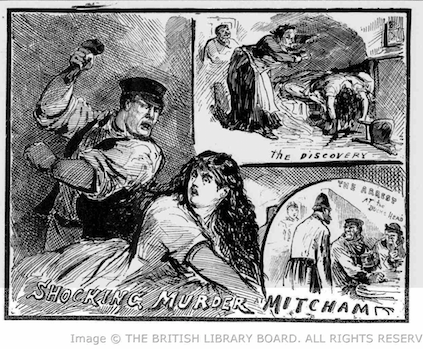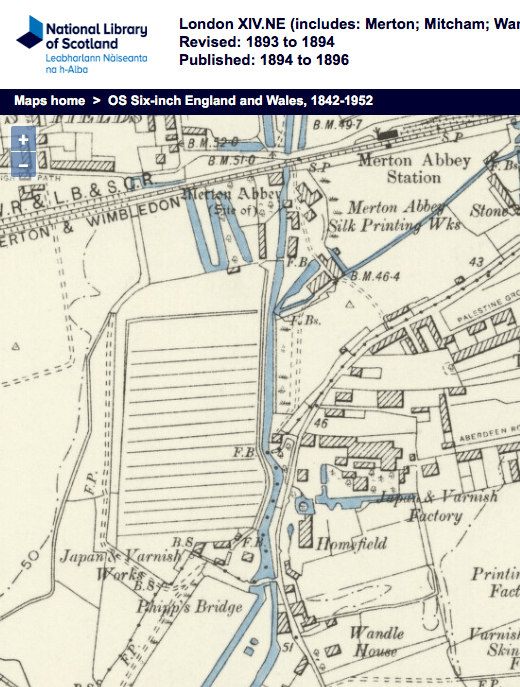From the Illustrated Police News – Saturday 07 June 1890
MURDER AT MITCHAM.
ON the 30th ult., at the Croydon County Bench, before Dr. Alfred Carpenter (in the chair) and other magistrates, George Bowling, fifty-one, a labourer, of Miles’s-cottages, Mitcham, was charged, on remand, with the wilful murder of Elizabeth Nightingale, a widow, with whom he lived, by smashing in her skull with a hammer, at Mitcham, on the 17th. ult.
Sophia Collins, sister of the deceased, had her previous evidence read over, and in reply to further questions said it was a four-roomed house. The prisoner and the deceased occupied the two front rooms, one up and one down. Witness and her brother occupied the other rooms. The deceased and Bowling had the exclusive use of the front door, of which they had the key, and they generally shut the door when they went out. Bowling and deceased lived together for ten or eleven years. Witness and her brother always used the back-door, which was bolted inside at night time. Of late the prisoner had been drinking very much, and quarrels between the pair were frequent. The deceased was of sober habits generally. Witness was on good terms with her. Had never seen her the worse for liquor. Witness usually saw her sister every day, if she did not the prisoner. The deceased worked at a marketgarden, and used to get there at eight o’clock. She would get up between five and six to do her housework. At this point Police-constable Butler, 488 W, produced a plan he had made of the premises, the bedroom being drawn to scale. The witness Collins went on to say that she last saw her sister alive on the 16th ult. The prisoner came in about eight o’clock. Witness did not see him, but she knew his step. She was surprised at his coming home so early. The deceased came in at half-past nine, and remarked to wltness as she was going upstairs, “Aint it cold? Directly she got in her room witness heard deceased and Bowling quarrelling. She heard the prisoner threaten her a good deal. He said, “I will be the death of you.’ She did not hear any blows, nor did she hear any scuffling. Soon after that prisoner came downstairs and seemed to go in his front room, and remained in there about five minutes. Witness heard him go up again. There was more swearing, but she heard no blows. This lasted five or six minutes, and all was quiet after- wards. Witness then went into the washhouse to get water and chop some wood, being absent about a quarter of an hour. Witness heard nothing more during the night. Witness’s brother came in about eleven o’clock, and stayed up about half an hour, and then went to bed. No one else went in or out of the house that night. Next morning, between five and six o’clock, she heard the prisoner come downstairs. Between five and six the same evening she went Into her sister’s bedroom and found her lying on the bed dead, with her skull battered in. Witness had seen a coal hammer in Bowling’s coal-cellar, but not during the past six months. Witness had used it for nailing pictures up. The hammer (produced, stained with blood) was not the one in question, in fact, she had never seen it before. She had several times heard the prisoner threaten to settle her sister. Cross-examined by Mr. Dennis: The last sound she heard was at ten minutes past ten o’clock. She did not know that Bowling went out at ten o’clock, and was drinking at the Buck’s Head public-house shortly before eleven. Witness was not surprised to hear them quarrelling, as it so frequently occurred. Her sister was rather a warm-tempered woman.
Dr. Henry Love repeated the evidence he gave before the coroner as to the death of the woman being caused by repeated and violent blows on the head by a heavy instrument such as the hammer produced. The fact of there having been no struggle showed that the woman was stunned by the first blow.
Inspector Butters, who arrested the prisoner, stated that on the way to the station Bowling said, “I suppose they fetched you ?” Witness replied in the affirmative. Police-constable Banfield, 277 W, deposed that the prisoner said to him, “It was in my temper I done it in.” Other evidence having been called, Mr. Dennis, in reply to the Bench, said he had nothing to say. In answer to the usual caution, the prisoner, speaking with some emotion, said, “Not guilty, and I reserve my defence,”
The prisoner was fully committed for trial at the next assizes on the capital charge. He was removed to Holloway Gaol to await his trial, his departure being witnessed by a large crowd.
Surrey Independent and Wimbledon Mercury – Saturday 2nd August 1890
The Mitcham Murder.
The execution of George Bowling, for the wilful murder of a woman named Eliza Nightingale, with whom he had cohabited for several years at Mitcham, took place on Tuesday morning, at nine o’clock, at Wandsworth Prison.
The prisoner, who was 57 years of age, a labourer, had lived a miserable life with deceased. On the day of the murder the informer had been drinking, and soon after he got home they quarrelled, and the prisoner attacked the unhappy woman with a hammer and literally beat out her brains. The prisoner neither at the time of the horrible occurrence nor since his conviction showed any remorse for his conduct, indeed, he has all along appeared to be impressed with the idea that he was justified in committing the act of violence, on account of the provocation he had received.
He has been visited by a brother and some other relatives, but it does not appear that any attempt has been made, either by memorial or otherwise, to obtain a commutation of the capital sentence. A few days ago the prisoner made out a sort of will by which he bequeathed what he calls his ‘little sticks’ to a brother, and he also at the same time made a formal admission of his guilt.
Mr. Walter Bartlett, of Bedford-row the newly-appointed deputy of Mr. Hudson, the High Sheriff of Surrey, had the responsibility of superintending the carrying out of the sentence, and he arrived at the prison shortly before one o’clock, and went to the prisoner’s cell. The culprit was then pinioned by Berry and walked firmly to the scaffold. He was a short, thick set man, and a drop of over five feet was allowed. He appeared to be dead in an instant.



